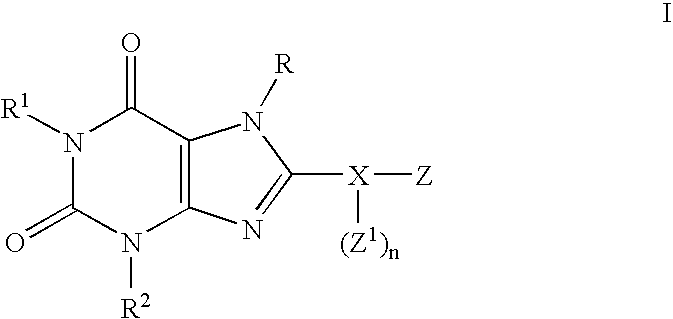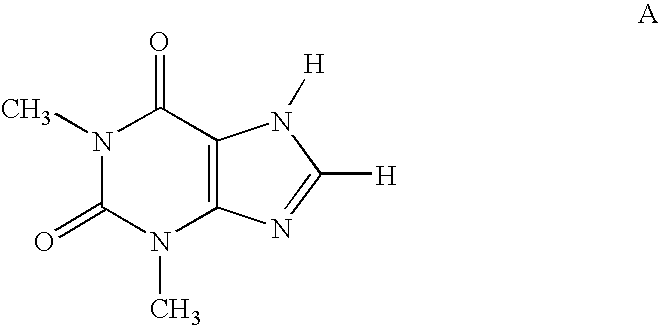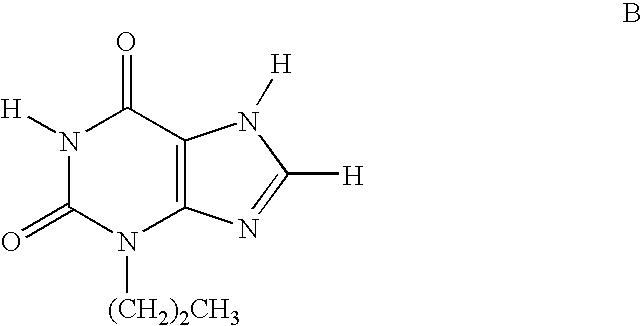Substituted 8-heteroaryl xanthines
a technology of 8-heteroaryl xanthines and substituted heteroaryl xanthines, which is applied in the field of substituted 8-heteroaryl xanthines, can solve the problems of only weakly blocking asub>1/sub> compound, and its use is associated with unpleasant side effects, so as to prevent mast cell degranulation
- Summary
- Abstract
- Description
- Claims
- Application Information
AI Technical Summary
Benefits of technology
Problems solved by technology
Method used
Image
Examples
example 1
General Procedure
Preparation of 6-chloronicotinoyl chloride
[0350]6-Hydroxynicotinic acid (1.444 g, 10.4 mmol) was suspended in thionyl chloride (8 ml). DMF (0.50 ml) was added. The mixture was refluxed for 2 h. After allowing the reaction to cool, thionyl chloride was removed by nitrogen stream and the residue was dried under vacuum overnight and used directly in the next step.
Preparation of 1,3-dipropyl-8-(6-chloro-3-pyridyl)xanthine (1)
[0351]6-Chloronicotinoyl chloride, prepared from 6-hydroxynicotinic acid (1.44 g, 10.4 mmol), in CH2Cl2 (20 ml) was added dropwise to a solution of 5,6-diamino-1,3-dipropyluracil (1.81 g, 8 mmol) in dry pyridine (8.2 ml) maintained at 5° C. The reaction was warmed to room temperature and stirred for an additional 3 hours. Water (50 ml) was added to quench the reaction. The solvent was evaporated to afford a dark colored oil. The oil was refluxed for 2 h in 2N NaOH (20 ml). After cooling, the pH was carefully adjusted to 7 with concentrated HCl. A so...
examples
[0357]The following compounds of the invention were prepared using the procedures described herein-above.
Compound 1: 1,3-Dipropyl-8-(6-chloro-3-pyridyl)xanthine
[0358]1H NMR (DMSO, d6): δ 0.89(m, 6H), 1.59(m, 2H), 1.73(m, 2H), 3.88(t, 2H, J=7.2 Hz), 4.00(t, 2H, J=7.2 Hz), 7.68(d, 1H, J=8.4 Hz), 8.50(dd, 1H, J1=2.4 Hz, J2=8.4 Hz), 9.07(d, 1H, J=2.4 Hz). MS: m / z 348 (M+H)+.
Compound 2: 1-Propyl-3-propargyl-8-(6-chloro-3-pyridyl)xanthine
[0359]MS: m / z 316 (M+H)+.
Compound 3: 1,3-Dipropyl-8-(6-ethylamino-3-pyridyl)xanthine
[0360]1H NMR (DMSO, d6): δ 0.89(m, 6H), 1.14(t, 3H, J=7.2 Hz), 1.56(m, 2H), 1.72(m, 2H), 3.33(m, 2H), 3.84(t, 2H, J=7.2 Hz), 3.99(t, 2H, J=7.2 Hz), 6.52(d, 1H, J=8.7 Hz), 7.09(t, 1H), 8.00(dd, 1H, J1=2.4 Hz, J2=8.7 Hz), 8.72(d, 1H, J=2.4 Hz). MS: m / z 357 (M+H)+.
Compound 4: 1,3-Dipropyl-8-(6-(2-hydroxyethyl)amino-3-pyridyl)xanthine
[0361]1H NMR (DMSO, d6): δ 0.88(m, 6H), 1.57(m, 2H), 1.71(m, 2H), 3.36(m, 2H), 3.53(m, 2H), 3.85(t, 2H, J=7.2 Hz), 3.99(t, 2H, J=7.2 Hz), 4.73(t,...
PUM
| Property | Measurement | Unit |
|---|---|---|
| temperature | aaaaa | aaaaa |
| diameter | aaaaa | aaaaa |
| pH | aaaaa | aaaaa |
Abstract
Description
Claims
Application Information
 Login to View More
Login to View More - R&D
- Intellectual Property
- Life Sciences
- Materials
- Tech Scout
- Unparalleled Data Quality
- Higher Quality Content
- 60% Fewer Hallucinations
Browse by: Latest US Patents, China's latest patents, Technical Efficacy Thesaurus, Application Domain, Technology Topic, Popular Technical Reports.
© 2025 PatSnap. All rights reserved.Legal|Privacy policy|Modern Slavery Act Transparency Statement|Sitemap|About US| Contact US: help@patsnap.com



